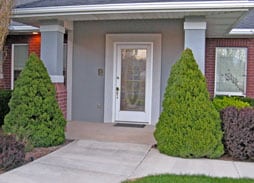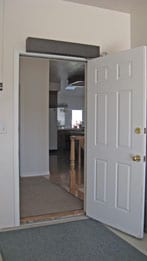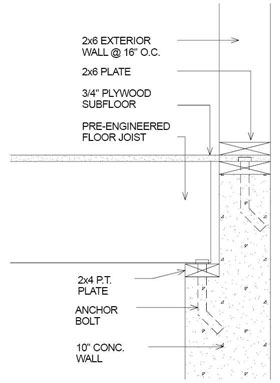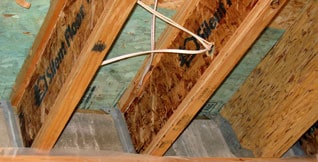Accessible Foundation

 Providing unimpeded access into the home from outside is one of the most important characteristics of an accessible home. Preferably access should be available from every external door in the home including the garage (See pictures above and at right). Moreover, this access should be provided without the use of obtrusive methods such as ramps.
Providing unimpeded access into the home from outside is one of the most important characteristics of an accessible home. Preferably access should be available from every external door in the home including the garage (See pictures above and at right). Moreover, this access should be provided without the use of obtrusive methods such as ramps. This ideal type of accessibility is nearly impossible to provide for most existing homes. However, if you are building a new house it can be achieved, at a price, by using some non-traditional building techniques.
In those parts of the country where houses are built on a concrete slab full accessibility is relatively easy to achieve since floor level is normally 6???-10??? above the final grade. This makes it relatively easy to bring the sidewalks, porches and driveway up to this same elevation with a very moderate rise from final grade.
Unfortunately, the floor level in a typical house with a basement is normally 2'-3' above final grade. This conventional building technique is unacceptable for a fully accessible home. The secret to achieving full accessibility is to construct the house so that the floor level is around 8" above final grade. The following modifications from traditional building techniques are required to build a fully accessible house:
Different Construction Technique
 In order to have the floor level close to final grade, one of two different methods must be used for attaching the floor to the foundation wall:
In order to have the floor level close to final grade, one of two different methods must be used for attaching the floor to the foundation wall:- Notch the top of the foundation wall ??? As you can see from the drawing to the right it is possible to pour a notch in the top of the foundation wall. In this case the floor joists are supported on the bottom of the notch rather than on the top of the foundation wall. Using this technique the resulting floor level is only 2" above the top of the foundation. If the top of foundation is 6"-8" above the final grade, then the floor level is 8"-10" above final grade which makes full accessibility possible. We plan to use this technique on our new house.

- Hang the floor joists from the top of foundation. This uses a special joist hanger designed to allow the joists to be hung from the top of the foundation. In the picture to the right you can see how the joist hangers are hanging from the top of the foundation sill plate. This is another technique that achieves the same effect as the first. It results in a floor level that is just 2" above the top of foundation and about 8"-10" above the final grade.
Higher Foundation Walls
A typical foundation wall is usually approximately 8' tall with the floor joists placed on top of it. Once the basement floor is poured the typical basement ceiling height is around 7'-8'. In an accessible home the floor joists are about a foot lower in relationship to the top of foundation as explained above. Therefore, it is also required to make the foundation walls taller so the height in the basement is acceptable. In an accessible house the walls are normally made 10' tall resulting in a basement ceiling height of 8'-8". This extra height is a real plus especially if you plan to finish the basement.Deeper Hole for the Foundation
The hole that needs to be excavated for a fully accessible home needs to be deeper than for a typical house for two reasons:- Foundation walls are taller. Since a 2' taller foundation wall is required, the foundation hole needs to be 2' deeper as well.
- Top of foundation is set closer to the final grade. Typically the top of foundation is set at about 18"-24" above final grade. With an accessible house the top of foundation is set 6"-8" above final grade. Consequently, the foundation needs to be set about 12"-16" deeper.

